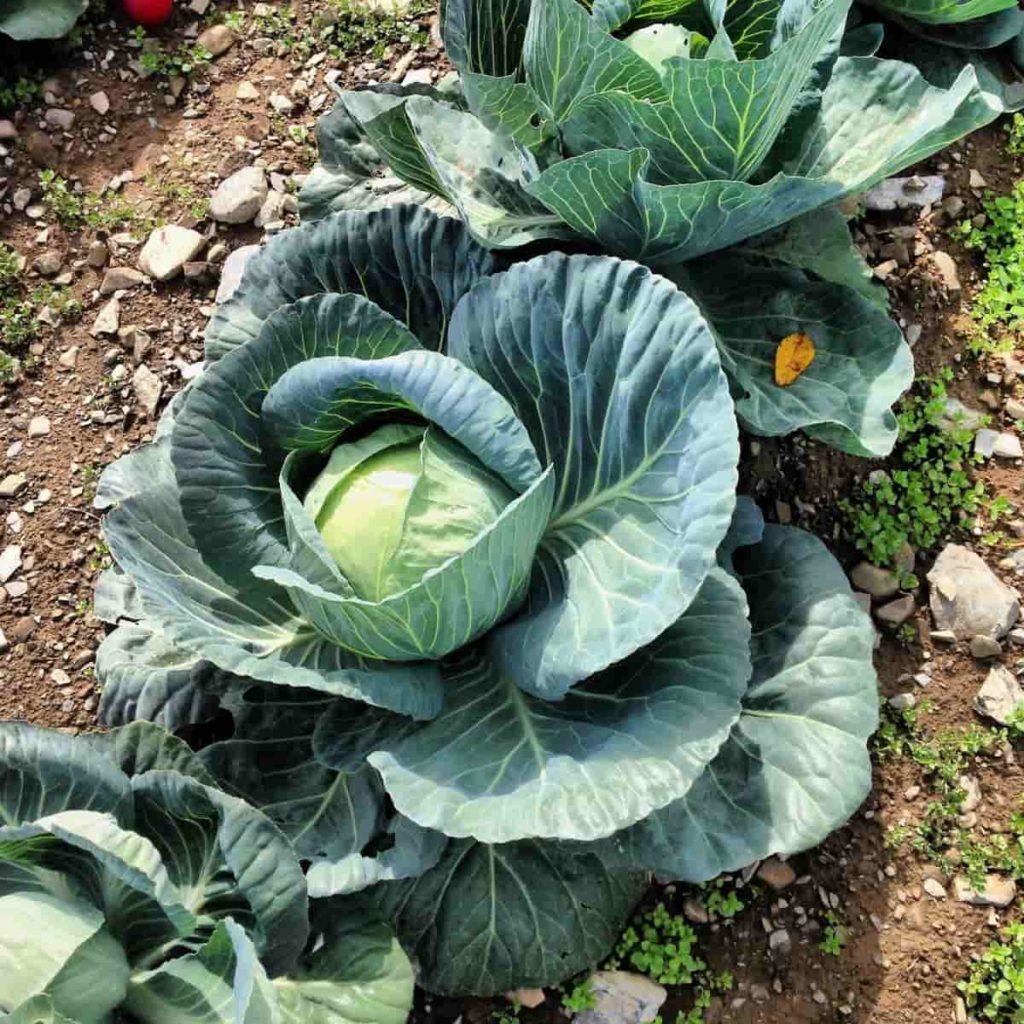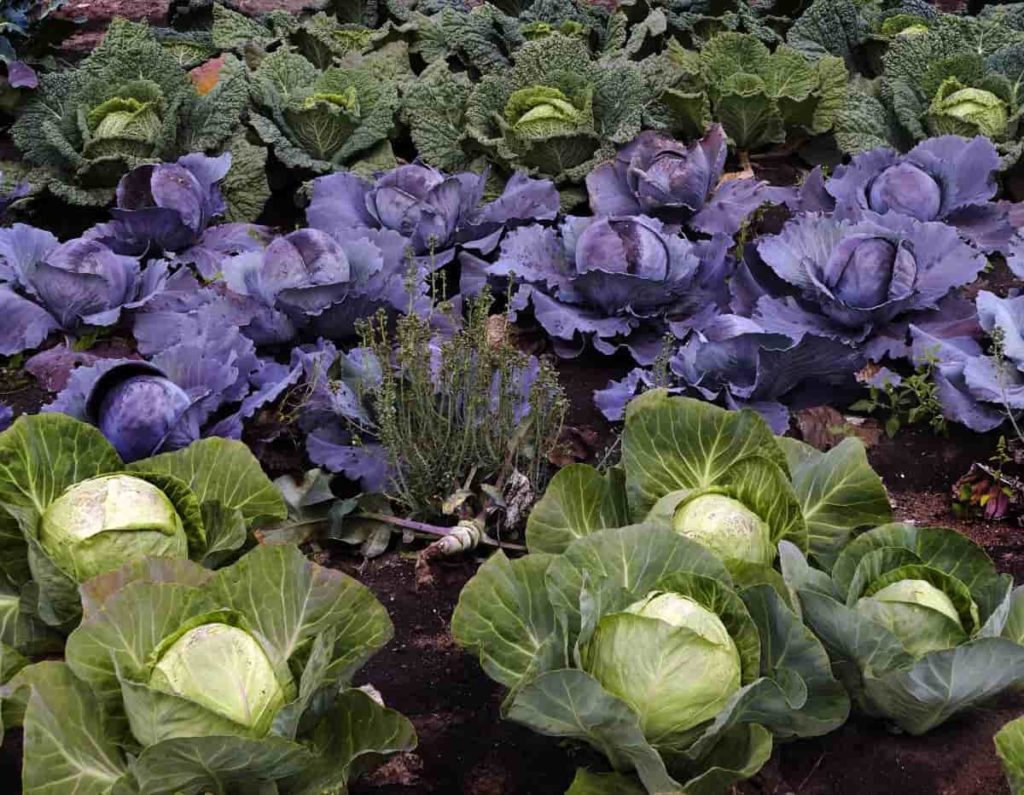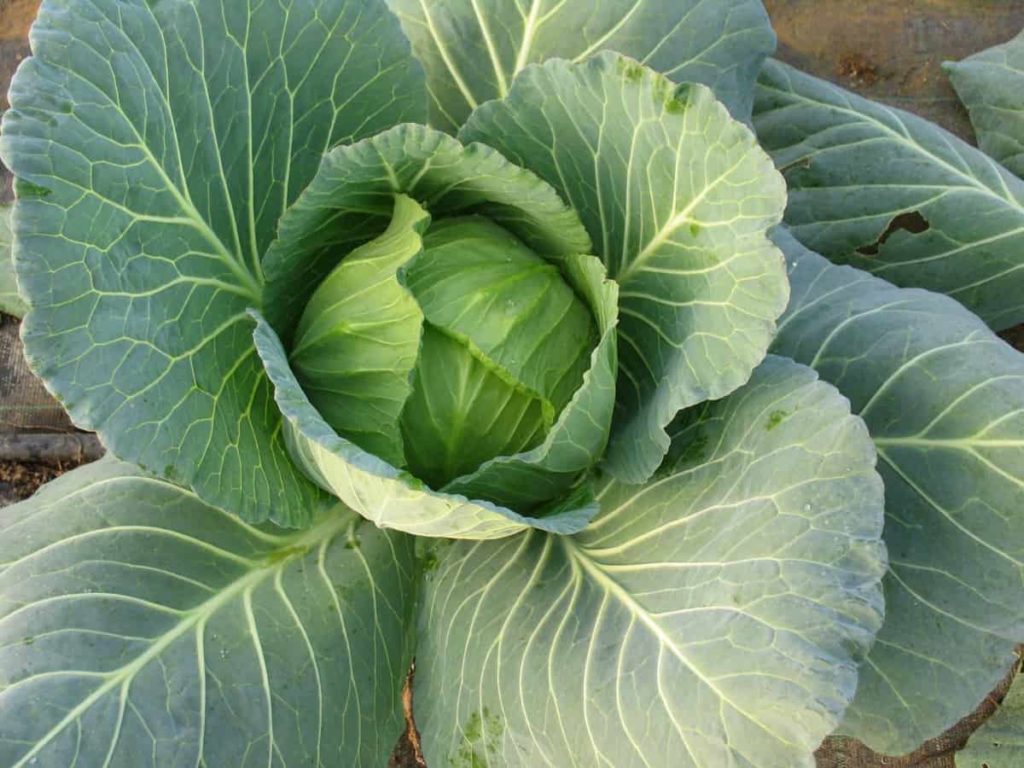Cabbage is a popular crop grown all over India for its delicious greens. Cabbage is a plant that thrives in nutritious, well-drained soil. You must do proper ground preparation before planting seeds or transplanting young seedlings. The best way to have thriving plants and good quality is to keep the soil constantly moist. Let’s check out how to prepare the soil for Cabbage plants.

Cabbage is an easy crop to grow and does not require much-advanced planning. However, there are some things you would like to check on your to-do list before planting the seed. Cabbage can be grown in various soils, from sandy loam to clay soil. Organic matter-rich soil with good drainage is all your Cabbage plants need to thrive. Sandy soil is best for root vegetables like Carrots and Potatoes as it is loose and will not restrict root growth. And yet, Cabbage will allow easy root development in sandy soil.
Sandy soil warms faster than other soils, which can help early growth. However, when the sun appears, the sandy soil dries up very quickly, which can be harmful to the growth of Cabbage. Just as sand cannot hold water well, it cannot hold on to nutrients, which can be easily washed in heavy rain or regular water. Therefore, it leads to a higher risk of nutritional deficiency in sandy soils. The loam soil is ideal for Cabbage growth, significantly when modified with organic matter such as compost.
How to prepare the soil for Cabbage plants
Soil pH for Cabbage
As with almost all plants, soil pH plays a decisive role in both the proper movement of nutrients in soil resolution and in creating conditions conducive or inappropriate for the development of various organisms. Keeping this in mind, the soil requirements of the Cabbage is slightly acidic to slightly alkaline soil, which ranges between 6 and 7.5. When the soil has less than pH 6, the availability of nutrients and trace elements, which are essential for the proper growth of Cabbage plants, are negatively affected. The addition of calcium to the soil is very important after that.
In case you missed it: 20 Common Cabbage Plant Problems: How to Fix Them, Solutions, and Treatment

Preparation of soil for growing Cabbage on grounds
Although Cabbage is not fussy about soil, it is good to use soil with enough drainage. Cabbage has a short taproot with lots of lateral roots, so keep in mind that it needs vertical and horizontal space. Adding compost can improve soil structure. Since plant leaves are the part we eat, modifying the soil with manure ensures it is cured well and until it is taken to the soil when preparing it before planting.
Cabbage can be cultivated on sand-heavy soil rich in organic matter. Early crops prefer light soil, while late crops thrive better on heavy soils due to moisture retention. On heavy soils, plants grow more slowly. Work the soil up to 12 to 18 inches, modify the soil with generous amounts of aged manure (sheep, cows, goats, horses), and work organic material well.
If the soil pH is not within the range, consider applying lime. However, be careful when applying too much lime; the essential element manganese is unavailable for Cabbage plants. Always check your garden soil pH. Cabbage grows well in sandy, loamy, and full sunshine availability.
Preparation of soil for growing Cabbage in pots
Your soil should be light and loamy mixed to allow moisture retention while effectively eliminating excess moisture. A pH of 6 to 7.5 would be ideal for growing Cabbage in containers. You can convert the pH of acidic soil by placing it in a lime powder. You prefer to mix the soil with mature compost before planting to encourage growth. Keep in mind that mature compost is needed to prevent crops from being affected by the process of the unfinished decaying process.
Cabbage plants prefer loam soil. The loam soil is easily available in most garden centers. It is just a standard compound with equal sand, silt, and clay parts. It may not seem much, but the loam soil provides exceptional drainage. However, standard bagged soil is not enough to help your plant reach its full potential. Like all vegetable plants, Cabbage needs to grow in nutritious soil. The best way to improve nutrients is to add some organic compost.
Work the compost in the soil so that it is fully added. Make sure that the compost inserts soil from the bottom to the top of the pot. It’s better to do it a few months before planting. Finally, you will need to check the pH balance. Cabbage is not super picky about pH levels. It will grow in a slightly acidic, slightly alkaline, or neutral environment.
However, you are more likely to experience abundant growth in soil with some mild acidity. Test the soil and add a small amount of sphagnum moss to reduce the pH. It is better to keep things neutral than to make the soil too acidic or alkaline.
In case you missed it: Best Fertilizer for Cabbage: Homemade, Natural, Organic, and NPK

How to grow Cabbage in Clay soil
Cabbage can grow in clay soil, but it needs to be taken care not to have much water. Loosening heavy, clay soil before transplanting can temporarily reduce soil computation and improve growth. However, clay soil has the opposite problem as sandy soil: it persists in too much water. In extreme cases, young Cabbage plants can die from root rot when the soil is constantly flooded.
In addition, the soil is extremely dense, making it difficult for the roots to penetrate the soil. The result has stopped the growth of Cabbage. Clay soil is a rich source of minerals and micronutrients essential for plant growth. The problem with heavy clay soil is the basic structure of the soil, which can compact very easily. Therefore, clay soil is recommended to be loosened with a cultivator or tiller (by hand or machine) before transplanting Cabbage and adding compost and manure to the soil.
Soil composting for Cabbage
Compost is the best way to improve the soil, but building soil rich in microbial life and nutrients can take time. Water and nutrient retention of sandy soil can be improved by the Compost and loosening the structure of clay soil. If your ground has sandy or clay soil, you can till compost into the top few inches of soil to immediately improve it.
Add a layer of compost to your native soil every year to gradually build a thick layer of rich soil. For those looking for a shortcut, if you have the time and money to invest in raised beds, you can fill raised beds with loamy soil or a mix of soil and compost. Cruciferous vegetables respond well to composted or well-aged animal manure, especially poultry.
In case you missed it: Cabbage Questions and Answers – Planting FAQs

Land preparation for Cabbage
Plants depend on soil for physical support, nutrients, and water. The extent to which soil provides these factors properly depends on topography, soil type, soil structure, and soil fertility. In cultivated conditions, soil and fertilizer management are two important factors affecting plant growth and production.
Land preparation involves one or more farming operations that loosen, pulverize, smooth, or firm the soil and make it more conducive to plant formation and root development. The growth of Cabbage and leafy green roots is influenced by soil profile. Cabbage and leafy greens are shallow roots; in favourable conditions and properly prepared soil, the roots will grow from 18 to 24 inches.
Cabbage may be planted or transplanted on flat or raised beds because the raised bed will warm up more quickly and enhance the earlier growth of Cabbage. In addition, cabbage does poorly in excessively wet soils. Raised beds facilitate drainage and help prevent wet feet in low or poorly drained soils. However, consider that Cabbage or leafy greens planted on raised beds may require more irrigation during drought conditions.
Remove debris from the previous crop. When the land is being cultivated for the first time, it should be plowed twice at two weeks intervals to minimize the growth of weeds. Grow Cabbage in well-drained soil rich in organic matter. When the soil is acidic or alkaline Apply agricultural lime by broadcasting two weeks before transplanting. The rate of lime application is between 4 to 5 kgs per 10 square meter plot.
Best potting soil for Cabbage
With Cabbage, you need to be a little careful with the soil. A quality, light potting mix rich in humus and a little clay will do wonders for its development. Cabbage grows best in moist soil, so choosing a substrate that holds some moisture and drains well is always good. Adding 1/4 share of peat moss or coco peat to the potting mix will work best.
In case you missed it: Cabbage Growing Tips, Tricks, Ideas, and Secrets

Soil recipe for Cabbage
You can either use the potting mix of the following combination – One-and-a-half-part peat moss or cocopeat, 1 part compost, 1 cup perlite, or you can use garden soil with the following combination- One-and-a-half-part Garden Soil, 1 part Manure, One-and-a-half-part Sand (construction sand). You can change the quantity of sand according to how sandy your garden’s soil is.
Natural soil amendments for Cabbage
If you’re growing Cabbage in the warmer months of the summer, you can use plant-based organic soil amendments, like alfalfa meal or soy meal. If you’re growing Cabbage in spring or fall cooler months, choose manure or animal-based soil amendments. Cabbage likes a little competition from constant water and weeds. After plants are established, mix with organic materials such as straw or untreated grass clippings. It will help in controlling weeds and maintaining soil moisture.
About one month after planting, add a small handful of high nitrogen fertilizer per plant, such as soybean meal or fish emulsion. Do not give fertilizer after that, as it can cause the head to grow and burst very fast. Torn heads are an open invitation to disease. Fill buckets with weeds and herbs and cover them with water and nets to keep the pests out. After a day in the sun, strain the plants and use a water solution to compost your plants.
You should include borage, horsetail, chickweed, natal, and comfrey. Apart from proper fertilization, Cabbage needs sufficient water to grow well. You should give about 1 inch of water every week, adding supplementary irrigation if there is insufficient rain. Add weed-free mulch to the Cabbage Garden to help keep the soil moist and discourage the growth of weeds that can withstand shallow Cabbage roots.
What to do with soil after growing Cabbage
Cabbage is a powerful root system that goes deep into the earth. It takes nutrients from the upper and lower soil layers. Do not plant crucifers in the same area every year; otherwise, they will be exposed to diseases and pests that are dangerous to their family and will not give the crop you are relying on. You should return them to the same place after 3 to 4 years. On a Cabbage bed, unadulterated plants feel well, and vegetables need a different dietary recipe.
After Cabbage, the soil is suitable for growing the following crops: Potatoes, Carrots, Cucumbers, Tomatoes, Black Pepper, Onions, Garlic, Beans, Peas, Beans, Beetroot, Eggplant, Squash, Pumpkin, Dill, Celery, Watermelon, Parsley, Spinach. However, you should not rely only on compliance with crop rotation. Cabbage crop rotation depends not only on which insects the garden crops are affected but also on how many nutrients plants consume and what kind of soil they leave.
In case you missed it: Growing Cabbage In Polyhouse – Greenhouse In India

Observance of the proper rotation of vegetable crops contributes to more effective control with the rational use of pests, fertilizers, and increased production. Onions are planted after plants before winter, which loosens the soil thoroughly. Since the Cabbage root system goes deep into the earth, the soil loosens after being harvested. Bed free from Cabbage heads is a great place to plant winter Onions. Soil is rested after Cabbage. It has plenty of nutrients left in it for the full growth of carrots. So, you can sow carrots next year after Cabbage.
- How to Grow Tomatoes Organically at Home: A Comprehensive Guide
- Organic Gardening on a Budget: Low-Cost Methods and Materials
- Gongura Seed Germination and Planting Methods
- Cabbage Seed Germination and Selection
- Broccoli Seed Germination and Selection
- Asparagus Seed Germination and Variety Selection
- Seasonal Flower Gardening: Best Practices for Spring, Summer, Fall, and Winter
- How to Grow Hibiscus from Flower
- Plantation Ideas for Home Decoration: A Beginners Guide
- Flower Garden Designs and Layouts for Beginners
- Planting and Spacing Techniques in Papaya: A Beginner’s Guide
- Growing Gold: Essential Techniques for Planting Pineapples
- How to Make Kalanchoe Plant Bushy: Home Remedies and Solutions
- 11 Reasons Why Your Gardenia is Not Blooming: Home Remedies and Solutions
- Eco Elegance: The Guide to Designing a Drought-Tolerant Landscape
- Gardening on a Slope: Strategies for Hillside Landscaping
- Nourish and Flourish: Top Organic Mulches for Thriving House Plants
- Everything You Want to Know about Indian Mogra Flower: Discover Uses and Growing
- Green Thumb Success: Expert Tips for Cultivating Greenhouse Pumpkins All Year Round
- Maximize Growth & Flavor: The Ultimate Guide to Companion Planting in Herb Gardens
- How to Control Rhododendron Problems Naturally: Home Remedies and Organic Ways to Fix Them
- Natural Magic: The Remarkable Benefits of Cinnamon for Plants
- Best Steps to Revive Dying Tulip with Natural and Organic Treatment
- 10 Reasons Why Your Angel Trumpet is Not Blooming: Remedies and Treatment
- How to Fix Periwinkle Leaf and Flower-Related Problems: Natural Remedies and Solutions
- How to Fix Zinnias Leaf and Flower Problems: Discover Natural and Home Remedies
- Organic Steps to Induce Lemon Tree Flowers: A Comprehensive Guide
- Bloom Booster: Crafting the Perfect Homemade Bougainvillea Fertilizer
- Optimizing Growth: A Guide to Applying NPK Fertilizer for Potted Plants
- 10 Best Homemade Fertilizers for Rubber Plant: DIY Recipes and Application Method
- How to Boost Female Pumpkin Flowers: Effective Steps for More Flowers and High Yields
- Transform Your Indoor Garden: Top Benefits of Pink Salt for Houseplants
- 10 Best Homemade Fertilizers for Peacock Plants (Calathea): Easy DIY Guide
- Unlock Blooms: 9 Reasons Why Your Potted Chrysanthemum is Not Blooming
- 8 Reasons Why Your Potted Hibiscus is Not Blooming: Fix it with Simple Solutions
- Unlock Blooms: 9 Key Reasons Your Potted Frangipani Won’t Flower